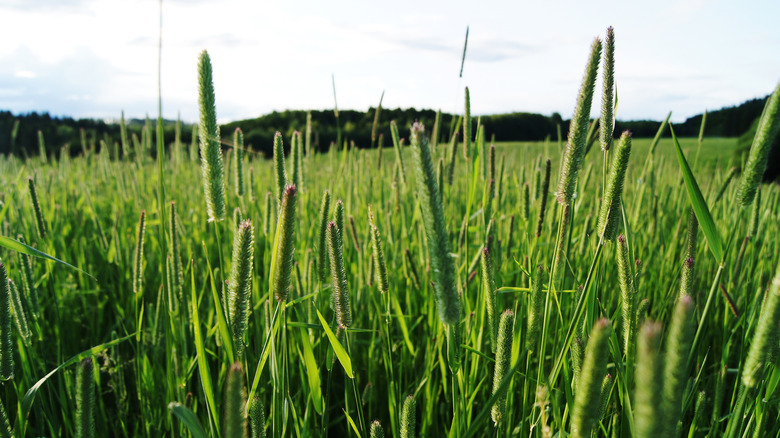How To Easily Identify And Care For Timothy Grass
We may receive a commission on purchases made from links.
Timothy grass (Phleum pratense), often called simply "Timothy," is a European grass that was introduced to the U.S. way back in the early 1700s. It's non-invasive and naturalized throughout the country, and as such, it's a popular agricultural pasture and forage grass. Some gardeners also grow it as an ornamental. What advantage does an ornamental grass have in your landscaping, you ask? Outside of being lovely to look at, Timothy is easy to care for and a beneficial plant to have in a wildlife garden. Lots of native and naturalized critters feed on it, from quail (they like the seeds) to butterfly larvae.
Timothy grass is most easily identified by its unusually bulbous stem bases, what horticulturists and botanists refer to as haplocorms, and its cylindrical inflorescences (clusters of flowers), which can grow to 6 inches long and don't droop as those of the superficial look-alike foxtail do. Bulbs and fluffy, spiky blooms are all that mark Timothy as different from other grasses. If you're attempting to identify it on a nature walk or in your own or another's garden, look closer at a mature seed head. Each tiny seed case should be topped by two horn-like spikes.
Perhaps surprisingly, Timothy could be considered among the colorful ornamental grasses to add to your landscape. It boasts unique gray-green foliage — a contrast to the often emerald hues of other grasses. Leaves help identify it at the seedling stage, too: If you notice a big twisted leaf in bird's-eye view, you know you've got a teeny Timothy plant. Physically, are you itchy, sneezing, or experiencing a runny nose? Timothy is one of the worst grasses for causing allergic reactions like hay fever.
Timothy isn't drought hardy like other ornamental grasses
This cool-season grass handles colder months, no problem; conversely, it struggles in the height of summer. It's also far from drought hardy. In the wild, it grows around ponds, streams, and ditches; in disused fields; and along roadsides. In other words, keep the soil consistently moist (though not saturated), or your clump of Timothy will fail to reach the 3-foot of height it's capable of. It prefers a neutral over acidic soil that's high in nutrients.
Thankfully, despite the flower heads producing lots of seeds and the plant being non-native, you won't have to prevent weeds from taking over your lawn and garden. Timothy is a perennial and doesn't survive long enough to get out of control in all but the most optimal of conditions. It has a shallow root system — unlike the many immensely deep-rooted native grasses — so don't use it for bank stabilization. Keep an eye out for signs of rust, brown leaf blight, grasshoppers, and eriophyid mites. New stands are especially vulnerable to wireworms and cutworms. Look for the rust-resistant 'Climax' variety.
Convinced? If you want to add Timothy to your garden, it's generally grown from seed. Walmart sells Everwilde Farms jumbo packets containing 1,000 wild Timothy grass seeds for under $4. Or, if you wish to cover a large area in Timothy, you can buy a pound of seed for just over $4 (with a 5-pound minimum) from Great Basin Seed. Sow the seeds up to a half-inch deep in the spring or summer. This gives the grass enough growing time before cold weather sets in.
